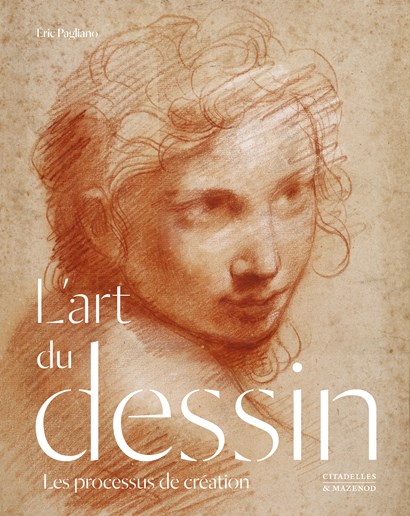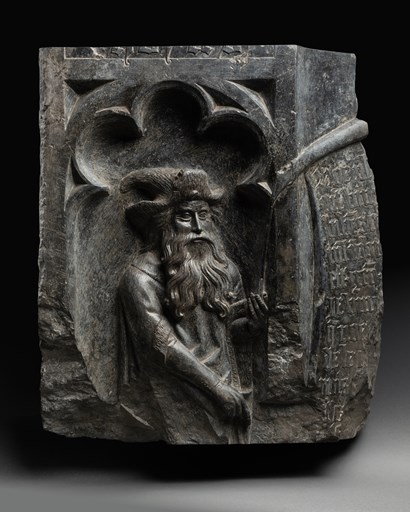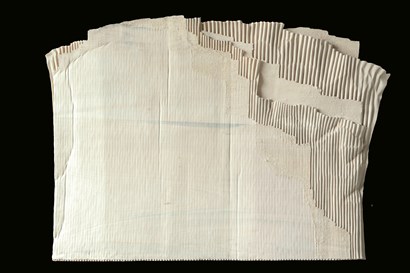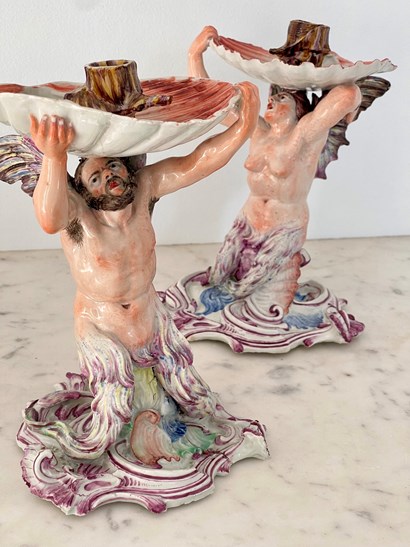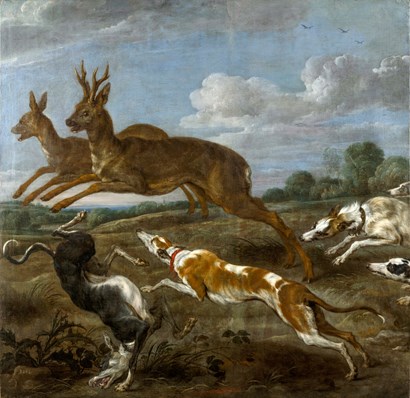This section will be available this Autumn.

Almine Rech
vivian springford
untitled
Vivian Springford (USA, Wisconsin 1913-2003 New York) Untitled, circa 1973 Acrylic on canvas 182.9 x 183.5 x 3.2 cm Provenance: estate of the artist Exhibition: Almine Rech, 'Gesture & Form: Women in Abstraction', May 3rd - June 15th, 2024, New York, Upper East Side Vivian Springford’s 'Untitled', circa 1973, encapsulates the American painter’s expressive, vibrant style. During the late 1960s, Springford had come into her own as an artist. She had developed a signature visual vocabulary and a technique of stain painting to go with it, working with thinned paint to create kaleidoscopic, gestural works.
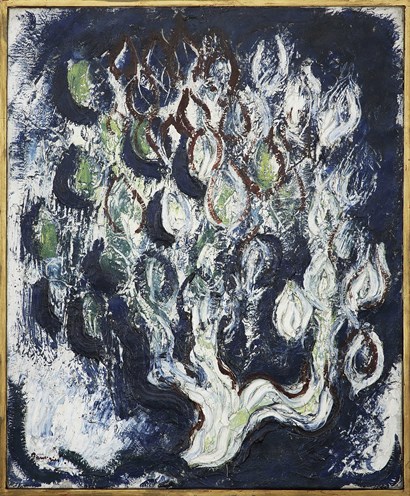
Galerie de la Béraudière
jean fautrier
Jean Fautrier (Paris 1898-1964 Châtenay-Malabry) Les feuilles vertes, 1934 Oil on canvas 73 x 60 cm Signed lower left 'Fautrier' Provenance: Jean Paulhan collection, France; Dominique Aury collection, France; private collection, France (by descent); Tajan, Paris, November 23rd, 2022, lot 44; private collection, Belgium Literature: Marie-José Lefort, Catalogue Raisonné de l'oeuvre peint de Jean Fautrier, Norma éditions, 2023, p. 293, n° 478 (ill.); Palma Bucarelli, Jean Fautrier, Pittura e materia, édition Il Saggiatore, Milan, 1960, ill. n° 107 p. 306 Exhibitions: 1974, Paris, Galeries nationales du Grand Palais, Jean Paulhan à travers ses peintres, cat. n° 563, p. 218
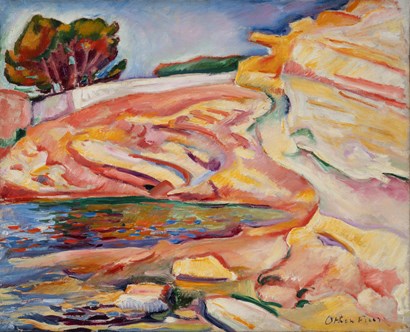
HELENE BAILLY MARCILHAC
Emile Othon Friesz (Le Havre 1879-1949 Paris) Bord de Mer, circa 1907 Oil on canvas 54 x 65 cm Signed lower right: Othon Friesz This work will be included in the forthcoming catalogue raisonné of the painted work of Emile Othon Friesz which is currently being prepared by the Galerie Aittouarès. Notice of inclusion n° 25361, delivered by Mrs. Odile Aittouarès on 3 January 2025

Kunsthaus Kende
Satoshi Hara (Japan, Yokohama, 1962) Flower vase with inlaid Chrysanthemum design (mujinagiku) Ishikawa, 2018 Gold, silver and iron H 18 cm - Ø 20 cm Provenance: artist’s estate Satoshi Hara, who was born in Yokohama, Kanagawa Prefecture in 1962, specialises in creating hammered metalworks embellished with intricate and labour-intensive decorations in gold and silver. This highly developed inlay technique makes the decorations appear as if they were drawn with a thin pen. The artist has created his own technique, which he calls ‘Nanako Zogan.’ With this technique, he is able to inlay patterns into the vessels using 0.3 mm-thick silver wires. Each individual line is created in five different steps. One piece of work contains an average of 50 metres of silver wire, meaning that the artist has to work with approximately 200 metres of silver wire throughout the various stages. There is no room for error in this highly complex and time-consuming process, since it is impossible to rectify any mistakes. The artist has been teaching metalworking at Kanazawa College of Art, Department of Craft, since 2003. His work can be found in numerous museums in Japan and abroad.
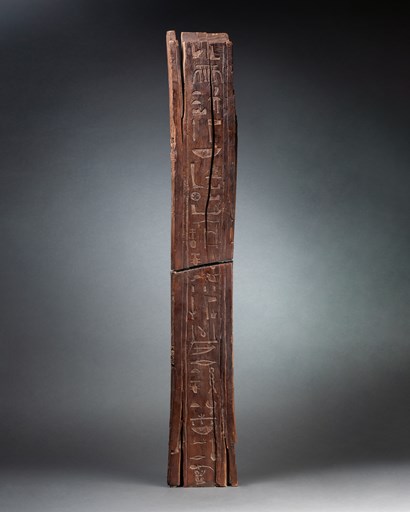
Desmet Fine Arts
Two fragments of a wooden sarcophagus corner post of the Priest Horudja re-united after 50 years Wood Egypt, late Dynastic period, 26th Dynasty, circa 664-525 BC H 92 x W 15 x D 5.5 cm Accompanied by Art Loss Register certificates: S00238635 & S00238636 Provenance: Fragment A: Chakib Slatine, Paris (acquired 1975); private collection, Paris (acquired 1977). Fragment B: Chakib Slatine, Paris (acquired 1975); private collection, Paris (acquired 1977); Ede Gallery, London (of which acquired in 2020)
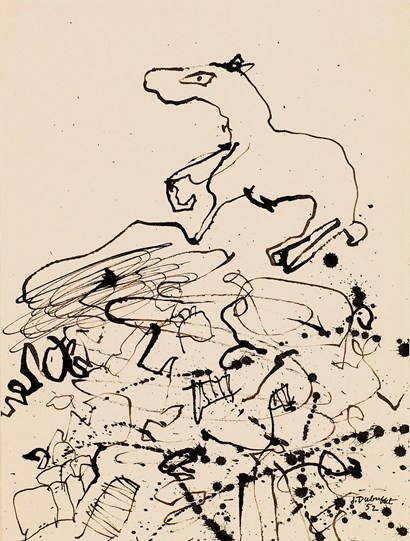
Galerie des Modernes
jean dubuffet
Jean Dubuffet (Le Havre 1901-1985 Paris) Terrain au Cheval 1, 1952 Indian ink (calame) on paper 30 x 22.5 cm Signed and dated lower right 'J. Dubuffet 52' Provenance: Pierre Matisse Gallery, New York, USA; Acquavella Modern Art, Reno, USA; Andrew and Christine Hall collection, Connecticut, USA; private collection, France; private collection, Belgium Literature: Max Loreau, Catalogue des Travaux de Jean Dubuffet, fascicule VII, Tables paysagées, paysages du mental, pierres philosophiques, Les Éditions de Minuit, Lausanne 1979, descr. and repr. on p. 109, n° 169 Exhibitions: Miro: early drawings collages 1919-1949 - Dubuffet: early drawings collages 1943-1959, Pierre Matisse Gallery, New York, November-December 1981; Dubuffet-Miro: selections from the Acquavella collection, Nevada Museum of Art, Reno, July-September 1997

Galerie Florence de Voldère
frederik bouttats l'ancien
Frédérik Bouttats the Elder (Antwerp, 1590-1661) Earthly paradise Oil on canvas 55.5 x 83 cm A painter of landscapes, paradises, and animals, he was also an engraver. He joined the Antwerp Guild as early as 1612. He had two pupils, as well as his sons Frédérik the Younger and Jacob. Founder of a famous family of artists, he contributed, along with his followers, to the influence and richness of Flemish painting through brilliant works under the influence of Velvet Brueghel, Jan van Kessel, and Roelandt Savery. To the great delight of naturalists and humanist scholars, the Breughels and their painter friends such as the Bouttats multiplied the themes of the Earthly Paradise, celebrating the beauty and diversity of creation. Like the Bird Traps, these paradises met with great success, and different versions can now be seen in the world’s greatest museums.
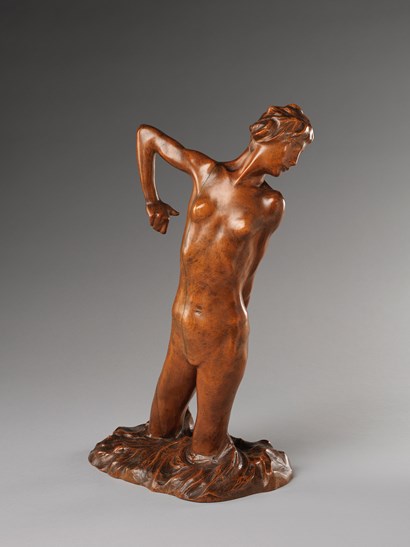
Thomas Deprez Fine Arts
george minne
George Minne (Ghent 1866-1941 Sint-Martens-Latem) Baigneuse I, 1899 Boxwood (composite) H 40 cm Signed on the base: ‘G. MINNE’ Provenance: private collection by family descent, Belgium Exhibitions: La Libre Esthétique, Brussels, 1902, cat. 139, as: ‘Figure de femme. boxwood.' Related literature: Arthur Roesler, George Minne, in: Deutsche Kunst und Dekoration, 1910, 14th year, IV, 2, ill. article frontispiece, p. 240 (cf. Waerndorfer marble); Léo Van Puyvelde, George Minne, Bruxelles : Editions des 'Cahiers de Belgique', 1930, cat. n° 31, p. 78, ill. pl. 31 (bronze); Robert Hoozee et al., George Minne en de kunst rond 1900, Gent: Museum voor Schone Kunsten, 1982, cf. cat. 95 & 96 (bronze and alabaster). Related exhibitions: Berliner Secession V, Berlin, 1902, cat. 319, as: ‘Badende’ (plaster); Wiener Secession XIV, Vienna, 1902, as: ‘Badendes Mädchen’ (plaster); Tento. Jozef Israëls & George Minne, Rotterdam, 1903, as: ‘Badende vrouw’ (marble); Berliner Secession XI, Berlin, 1906, cat. 332, as: ‘Junge Frau’ (plaster); Mücsarnok, Teli, Nemzetkozi Kiallitas, Budapest, 1908-09, cat. 285 (marble); Esposizione Internazionale d’Arte, Venice, 1909, cat. 3, as: ‘Bagnante’ (marble); Sonderbund westdeutscher K., Dusseldorf, 1910, cat. 237, as: ‘Die Badende’ (marble); Leipziger Jahresaustellung, Leipzig, 1912, cat. 895c, as: ’Baigneuse’ (bronze); Sonderbund internationale Kunstaustellung Köln, 1912, cat. 611, as: ‘Badende’ (marble). Related works: It has been said that George Minne, with the present sculpture, directly influenced Gustav KLIMT (1862-1918) for the painting 'Wasserschlangen I' (1904/07), cf. Hoozee. Its appeal, however, has never faded, as can be seen in several variations on the pose which have been an integral part of the famous Belgian contemporary choreographer Anne Teresa De Keersmaeker’s so-called 'Attitudes'. Note on versions: Van Puyvelde mentions editions in marble, wood and bronze. In addition, several fine plaster casts with family provenances can be identified, amongst others at the MSK Gent and at the Museum Gevaert-Minne. Among the early collectors of bronze versions we find Hélène Kröller-Müller and Karl Ernst Osthaus, partly due to the fact that Minne’s ‘Baigneuse I’ has been a favourite for the inclusion in decorative settings designed by Henry VAN DE VELDE (1863-1959). Versions in marble are held at the Royal Museums of Art & History and at the Belvedere in Vienna. We have been unable to find records of any other versions of Minne’s ‘Baigneuse I’ in wood. Executed in a fine composite of boxwood, it is likely a unique piece in the material and can therefore be identified as entry nr. 139 at La Libre Esthétique in 1902; where both a bronze version and a version in boxwood of Minne's 'Baigneuse' were exhibited under the title 'Figure de femme'. Interestingly, the 1902 exhibition of La Libre Esthétique in Brussels also marked the model's public debut, ranking the present version as one of the earliest in existance and one of the first two shown publicly.
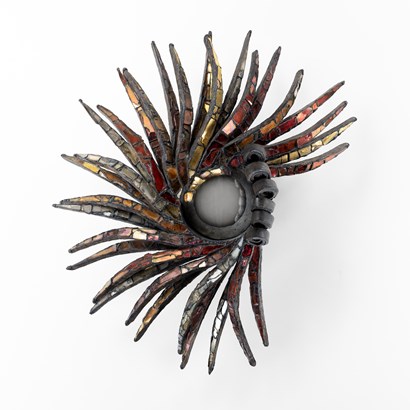
unforget Decorative Arts
line vautrin
Line Vautrin (Paris, 1913-1997) Crète de coq mirror, circa 1965 Talosel inlaid with mirror fragments H 50 x W 41.5 cm Diameter at sight of the central witch: 10 cm This work is accompanied by a certificate of authenticity issued by the Line Vautrin Committee “Crète de Coq”, mirror in black Talosel inlaid with mirror fragments, by Line Vautrin. This convex “witch mirror” features a radiant decoration of incised Talosel inlaid with polychrome mirror tesserae in shades of red, gold, copper, and silver. The spiral composition evokes the bristling energy and dynamic movement of a cockscomb, its form at once organic and architectural. A rare and technically demanding creation, Crète de Coq exemplifies Vautrin’s experimental mastery of Talosel - a material she both discovered and transformed into a medium of pure artistic expression. In this piece, she chose a warm palette of reds, oranges, golden ambers, and bronzed tones, creating a striking contrast with the deep black of the Talosel structure. The frame itself unfolds in six spiraling curves, each extending into a series of radiant, gently curved points that seem to shimmer and vibrate with light. Singular within her oeuvre, this asymmetrical spiral composition differs from Vautrin’s more familiar series, revealing her ability to reinvent form and rhythm through subtle variations. Crète de Coq is not merely a mirror, but a luminous, poetic sculpture - an enchanting testament to Line Vautrin’s imagination and her genius for turning humble materials into magical, living art.
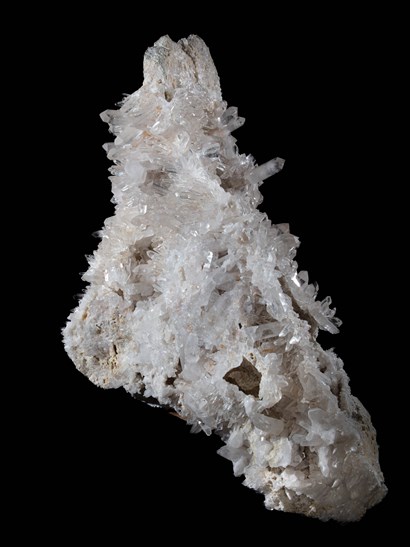
Stone Gallery
Quartz crystal cluster Weight: 350 kg 87 x 135 x 75 cm Origin: quarries of Mount Ida, Arkansas, USA, discovered in 1993 Provenance: Paul Membrini collection until 2023 Rock crystal is the crystallised, colourless variety of quartz, also known as clear quartz. All the crystals with their countless facets are 100% natural. With its transparent and colourless appearance, it is revered for its purity and clarity. This giant group of quartz crystals weighs approximately 350kg and is 87 x 135 x 75 cm. It displays remarkably perfect and water-clear crystals on all sides. Discovered in one of the famous crystal quarries of Mount Ida, Arkansas, USA, in 1993. The piece was once part of the Membrini Collection from Switzerland, a phenomenal museum-quality crystal collection, meticulously assembled over the years by Membrini Kristall, a firm based in Chur, Switzerland. Founder Paul Membrini was a renowned “strahler,” a professional crystal hunter who explored the Alps. Stone Gallery acquired the Membrini Collection in early 2023. Martin Garrix Stone Gallery proudly announces that the larger sibling of this piece, a great cluster weighing an impressive 4500 lbs, is now on display at the Naturalis Biodiversity Center in Leiden, in part thanks to Dutch DJ Martin Garrix.
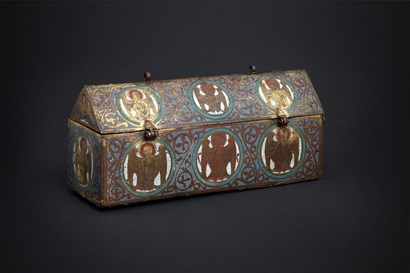
Art et Patrimoine - Laurence Lenne
Reliquary 'in the form of a sarcophagus with a hinged roof' Limoges, mid-13th century Gilt copper plates, champlevé enamels H 11.8 x W 27.5 x D 9.5 cm Literature: Inventaire général des monuments et des richesses artistiques de la France. Emaux limousins du Moyen Age. Correze/Creuse/Haute-Vienne, under the direction of Paul-Édouard Robinne, Éditions de l’Inventaire, Images du Patrimoine, 1995; Emaux de Limoges XIIè-XIXè siècle, under the direction of Jacques Toussaint, Museum of Ancient Arts of Namur, 1996; Valérie & Thomas Becket, De l'influence des princes Plantagenêt dans l'Oeuvre de Limoges, Municipal Museum of the Bishop’s Palace-Museum of Enamel, Limoges, 1999 A reliquary, without a wooden core, taking the shape of a sarcophagus with a hinged roof. It is made of gilt copper plates and decorated with champlevé enamels depicting sixteen half-length angels emerging from clouds against a white enamel background. The decoration consists of two superimposed registers of three engraved gilt angels set within round medallions. The medallions stand out against a blue enamel ground adorned with gilded Gothic foliage and interlace patterns. This reliquary belongs to a series of standardised reliquaries known from the Limousin region, all dating from the 13th century. Its dimensions make it one of the largest examples of this 'sarcophagus with movable roof' type. It is closely related to the exceptional large reliquary of Saint-Yrieix-la-Perche, classified as part of the Treasure of the French Historic Monuments.

Galeria Bessa Pereira
Abraham Palatnik (Brasil, Natal 1928-2020 Rio de Janeiro) Cupboard, 1950s Iron, wood and painted glass H 90 x W 150 x D 49 cm Origin: Brasil Provenance: private collection, Rio de Janeiro; Galeria Bessa Pereira collection Literature: Vicente, A., & Vasconcellos, M. (Comps.), Móvel moderno brasileiro (1st edition), São Paulo: Olhares, 2017, pp. 244-245; Vasconcellos, M., Móvel brasileiro moderno (1st edition), Rio de Janeiro: Aeroplano, 2012, p. 193

Collectors Gallery
Arman (Nice 1928-2005 New York) Capricorn brooch in gold Zodiac collection, 1994 Certificate of authenticity and copy of the artist’s original drawing on the letterhead of the Hôtel Lutetia, where the artist resided and designed the models for this collection Provenance: Galerie Pierre-Alain Challier, successor to Editions Artcurial
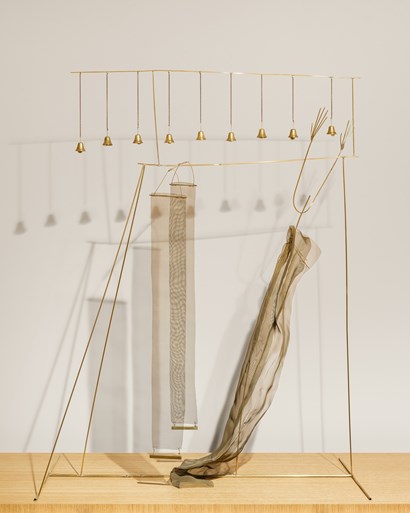
Pron
fausto melotti
Fausto Melotti (Rovereto 1901-1986 Milan) Il meridiano delle campane, 1979 Brass H 97.5 x W 74 x D 38 cm Literature: Milan, Galleria Stendhal, Cascella Consagra Melotti, 1980; Padua, Stevenson Arte Contemporanea, Fausto Melotti. Sculture, tecniche miste e incisioni, 1982; Intra, Galleria Corsini, Fausto Melotti. Sculture e Acquarelli. Un'opera d'arte è un'oasi, 1982; Busto Arsizio, Galleria Il Punto Sette, Fausto Melotti, 1984; Parma, Galleria La Sanseverina, Fausto Melotti, 1986, pp. 29, 47, n° 29, ill. Exhibitions: Gianni Cavazzini, Poetiche sosprese di Fausto Melotti, in Gazzetta di Parma, May 23rd, 1986, ill.; Germano Celant, Melotti, Catalogo generale, Tomo secondo, Sculture 1973-1986 e Bassorilievi, Milan 1996, p. 512, 1979 n° 21, ill.

Axel Vervoordt
Jef Verheyen (Belgium, Itegem 1932-1984 Apt, France) Untitled Matt lacquer on round board 100 x 100 cm - Ø 80 cm Provenance: private collection, Belgium; collection Axel Vervoordt, 2003; private collection, Belgium Exhibition: Jef Verheyen, Lux est Lex, Wijnegem, 2004, cat. n° 60, ill. p. 93

Galerie Perrin
oskar bergman
Oskar Bergman (Stockholm 1879-1963 Saltsjöbaden) The Lagan from Laholm, 1925 Watercolour and gouache on paper 19 x 30.5 cm Signed and dated lower right: Oskar Bergman, Lagan Fran Lahollni, April 1925 Provenance: private collection There are artists who throw themselves wholeheartedly into the various currents during the course of their lives, following the frenetic rhythm of fashions, becoming the icons of an historical moment or a particular group. Others, conversely, take a vow of fidelity to their nature, far removed from the ephemeral unfolding of art, working and meditating as if in a kind of reclusion on a subject to which they devote their entire work. Oskar Bergman belongs to the latter category. His long and prolific career was nothing more than a variation on the theme of landscape, interpreted in a highly personal style that is instantly recognisable, the result of his self-taught training and few outside influences.





